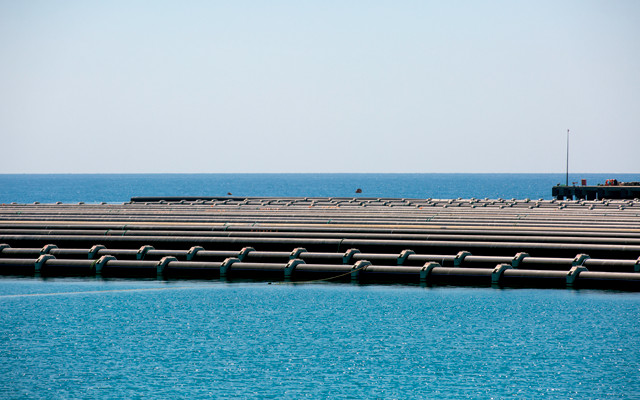
by Terri Cook Thursday, October 22, 2015

A pipeline, shown here under construction in May 2014, will bring water from Turkey to Cyprus. Credit: ©Shutterstock.com/muratart.
With its semi-arid climate and growing population, Cyprus suffers from the highest level of water stress in Europe and is ranked in the top five most water-stressed countries in the world, according to the World Resources Institute. Demand in the larger southern Republic of Cyprus is predicted to increase to 314 million cubic meters per year by 2020, up from 266 million cubic meters in 2004.
Meanwhile, the island has experienced increasingly frequent and intense droughts since the 1970s, resulting in an estimated 40 percent decrease in surface runoff, according to a 2004 report by Cyprus’ Department of Environment. These impacts are likely to increase in the future, with climate models predicting a decrease in precipitation in southern Europe, coupled with drier summers and even more frequent and intense droughts.
Whereas the Republic of Cyprus has increasingly turned to desalination — constructing two permanent and several mobile reverse osmosis plants with a total capacity of 20,000 cubic meters per day — northern Cypriots have instead turned toward Turkey, which controls the parched territory. In August, Turkey finished constructing the world’s longest undersea water pipeline, which will soon deliver water beneath the Mediterranean Sea to northern Cyprus. The estimated $550 million project will transfer up to 75 million cubic meters of water — enough to fill 30,000 Olympic-size swimming pools — each year from the Anamur River in Turkey’s southern Mersin province to the Mediterranean’s third-largest island.
The ambitious scheme will transport about 10 percent of the Anamur’s flow to Northern Cyprus via new dams and pumping stations constructed at both ends. The centerpiece of the project is the 80-kilometer-long, trans-Mediterranean pipeline. Unlike at most underwater installations, which are laid on the seafloor, the ruggedness of the basin and the water depths exceeding 1,400 meters required an unconventional engineering approach: tethering lengths of low-density, polyethylene pipe to the seafloor, allowing it to float just 250 meters below the surface of the sea.
After reaching Northern Cyprus, the water will be stored in a reservoir impounded by the Gecitkoy Dam, near the coastal town of Girne, before being divided almost equally between domestic households and farmland. The new source of water, which is expected to meet the isolated enclave’s increasing demands for the next 50 years, will allow Turkish Cypriots to irrigate nearly 5,000 additional hectares, providing a significant economic boost in a region where — as in the southern Republic of Cyprus — rainfall and groundwater often fall far short of meeting the demands for freshwater.
What effects the so-called Baris Suyu, or “Peace Water,” pipeline may have upon the prospects for Cyprus’ reunification are currently unclear. While some analysts argue that the new source of water will bring the two sides closer, others argue that the north’s increasing dependence on Turkey will drive them farther apart.
Regardless of the political ramifications, all Cypriots must try to use the water they have more efficiently. And with 5 percent of the demand coming from tourism, visitors to the island also have an obligation to curb their consumption while there.
© 2008-2021. All rights reserved. Any copying, redistribution or retransmission of any of the contents of this service without the expressed written permission of the American Geosciences Institute is expressly prohibited. Click here for all copyright requests.